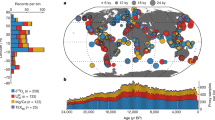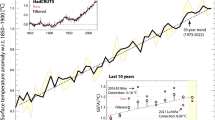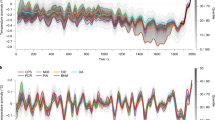Abstract
Data sets used to monitor the Earth’s climate indicate that the surface of the Earth warmed from ∼1910 to 1940, cooled slightly from ∼1940 to 1970, and then warmed markedly from ∼1970 onward1. The weak cooling apparent in the middle part of the century has been interpreted in the context of a variety of physical factors, such as atmosphere–ocean interactions and anthropogenic emissions of sulphate aerosols2. Here we call attention to a previously overlooked discontinuity in the record at 1945, which is a prominent feature of the cooling trend in the mid-twentieth century. The discontinuity is evident in published versions of the global-mean temperature time series1, but stands out more clearly after the data are filtered for the effects of internal climate variability. We argue that the abrupt temperature drop of ∼0.3 °C in 1945 is the apparent result of uncorrected instrumental biases in the sea surface temperature record. Corrections for the discontinuity are expected to alter the character of mid-twentieth century temperature variability but not estimates of the century-long trend in global-mean temperatures.
This is a preview of subscription content, access via your institution
Access options
Subscribe to this journal
Receive 51 print issues and online access
$199.00 per year
only $3.90 per issue
Buy this article
- Purchase on Springer Link
- Instant access to full article PDF
Prices may be subject to local taxes which are calculated during checkout




Similar content being viewed by others
References
Trenberth, K. et al. in Climate Change 2007: The Physical Science Basis (eds Solomon, S. et al.) Ch. 3 (Cambridge Univ. Press, Cambridge, UK, 2007)
Hegerl, G. et al. in Climate Change 2007: The Physical Science Basis (eds Solomon, S. et al.) Ch. 9 (Cambridge Univ. Press, Cambridge, UK, 2007)
Yulaeva, E. & Wallace, J. M. The signature of ENSO in global temperature and precipitation fields derived from the microwave sounding unit. J. Clim. 7, 1719–1736 (1994)
Wallace, J. M., Zhang, Y. & Renwick, J. A. Dynamic contribution to hemispheric mean temperature trends. Science 270, 780–783 (1995)
Robock, A. et al. Climatic consequences of regional nuclear conflicts. Atmos. Chem. Phys. 7, 2003–2012 (2007)
Folland, C. K. & Parker, D. E. Correction of instrumental biases in historical sea surface temperature data. Q. J. R. Meteorol. Soc. 121, 319–367 (1995)
Kent, E. C. & Taylor, P. K. Toward estimating climatic trends in SST. Part I: Methods of measurement. J. Atmos. Ocean. Technol. 23, 464–475 (2006)
Smith, T. M. & Reynolds, R. W. Bias corrections for historical sea surface temperatures based on marine air temperatures. J. Clim. 15, 73–87 (2002)
Rayner, N. A. et al. Improved analyses of changes and uncertainties in sea surface temperature measured in situ since the mid-nineteenth century: The HadSST2 data set. J. Clim. 19, 446–469 (2006)
Worley, S. J., Woodruff, S. D., Reynolds, R. W., Lubker, S. J. & Lott, N. ICOADS Release 2.1 data and products. Int. J. Climatol. 25, 823–842 (2005)
Kent, E. C., Woodruff, S. D. & Berry, D. I. Metadata from WMO Publication No. 47 and an assessment of voluntary observing ships observation heights in ICOADS. J. Atmos. Ocean. Technol. 24, 214–234 (2007)
Marine Observer’s Handbook 8th edn (HMSO, London, 1963)
Brohan, P., Kennedy, J. J., Harris, I., Tett, S. F. B. & Jones, P. D. Uncertainty estimates in regional and global observed temperature changes: A new dataset from 1850. J. Geophys. Res. 111 D12106 doi: 10.1029/2005JD006548 (2006)
Acknowledgements
We thank D. Parker and S. Solomon for comments on the manuscript, and R. Reynolds for reviews. D.W.J.T. and J.M.W. were supported by the NSF Climate Dynamics Program under budget numbers ATM-0132190 and ATM-0613082 (D.W.J.T.) and ATM-0318675 (J.M.W.). J.J.K. was supported by the Joint Defra and MoD Programme, GA01101 (Defra) and CBC/2B/0417_Annex C5 (MoD). P.D.J. was supported by the US Department of Energy (DE-FG02-98ER62601).
Author information
Authors and Affiliations
Corresponding author
Rights and permissions
About this article
Cite this article
Thompson, D., Kennedy, J., Wallace, J. et al. A large discontinuity in the mid-twentieth century in observed global-mean surface temperature. Nature 453, 646–649 (2008). https://doi.org/10.1038/nature06982
Received:
Accepted:
Issue Date:
DOI: https://doi.org/10.1038/nature06982
This article is cited by
-
Pacific variability reconciles observed and modelled global mean temperature increase since 1950
Climate Dynamics (2021)
-
Synchronized tropical Pacific and extratropical variability during the past three decades
Nature Climate Change (2020)
-
Sensitivity of Cloud Microphysics on the Simulation of a Monsoon Depression Over the Bay of Bengal
Pure and Applied Geophysics (2020)
-
Correcting datasets leads to more homogeneous early-twentieth-century sea surface warming
Nature (2019)
-
Projected changes of temperature extremes over nine major basins in China based on the CMIP5 multimodel ensembles
Stochastic Environmental Research and Risk Assessment (2019)
Comments
By submitting a comment you agree to abide by our Terms and Community Guidelines. If you find something abusive or that does not comply with our terms or guidelines please flag it as inappropriate.



